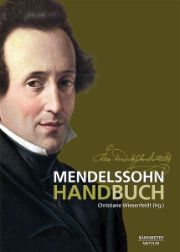Mirror of the overall work
The Mendelssohn Handbook shows the composer with the wealth of his work and in the context of his time.

A lot has happened in Mendelssohn research: thirty years ago there was only the extensive biography by Eric Werner, but since then a wealth of publications has piled up. These include the groundbreaking biography by R. Larry Todd and the edition of almost 6000 letters, which was completed in 2017. These heavyweight editions point to the rediscovery of Mendelssohn's complete works, which only really took off around 1990 after decades of oblivion.
As a result of this new departure, a volume on Felix Mendelssohn has now also been included in the commendable series of composers' handbooks published by Metzler and Bärenreiter. The enormous scope of the work edited by Christiane Wiesenfeldt impressively reflects the state of research on Mendelssohn's extensive oeuvre that has been achieved in a relatively short time. The diversity of his composing is present here, not only the large-scale symphonic and oratorio forms, but also many smaller works, which are also duly reflected.
There are the early works such as the string symphonies and the double concertos (for two pianos or for violin and piano), which are honored. But also the Singing songs outdoorsonce ridiculed as unworthy trifles, are given space. This shows how such aspects of the overall oeuvre have established themselves as fully valid components of a dazzling Romantic spirit.
In addition, this handbook pays particular attention to intellectual-historical phenomena that are relevant in connection with the person portrayed: Helmut Loos, co-editor of the Mendelssohn letters, provides insights into the culture of letters in the 19th century. An extensive section of 40 pages is devoted to the reception of Mendelssohn's music, the history of which ranges from Richard Wagner's anti-Semitic condemnation to the abstruse ban as "degenerate music" to its flourishing in the 1990s and which is still not free of clichés today.
The privileged family situation and the unprecedented early talent of the siblings Fanny and Felix are also discussed in detail. Beatrix Borchard illuminates these aspects knowledgeably and does not conceal Fanny's creativity. However, this is also the only flaw in the handbook, as more attention is not paid to Fanny's role in Felix's artistic work. The specialist Borchard could certainly have contributed an important article on the subject.
Overall, however, this Mendelssohn handbook offers a wealth of information and possibilities for use, ranging from quick reference to extensive reading. The almost 120-page section on vocal music alone shows the immense wealth of musical works that Mendelssohn gave us. The meticulous index allows the book to be used as a reference work.
Mendelssohn Handbook, edited by Christiane Wiesenfeldt, XX + 506 p., € 99.99, Bärenreiter/Metzler, Kassel/Stuttgart 2020, ISBN 978-3-7618-2071-1









